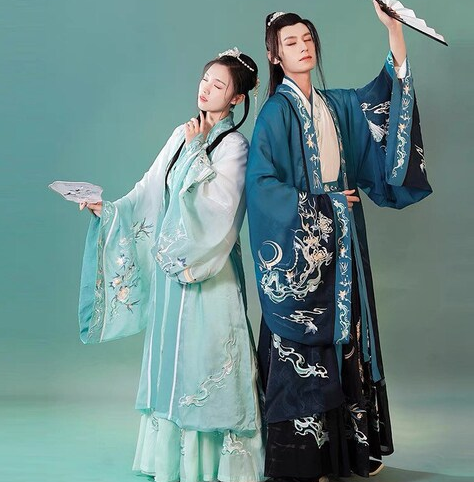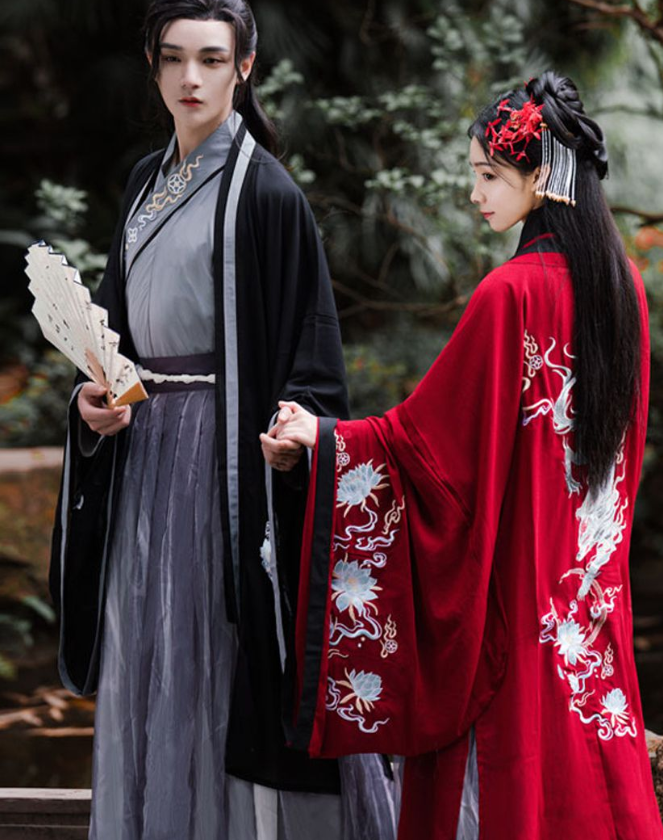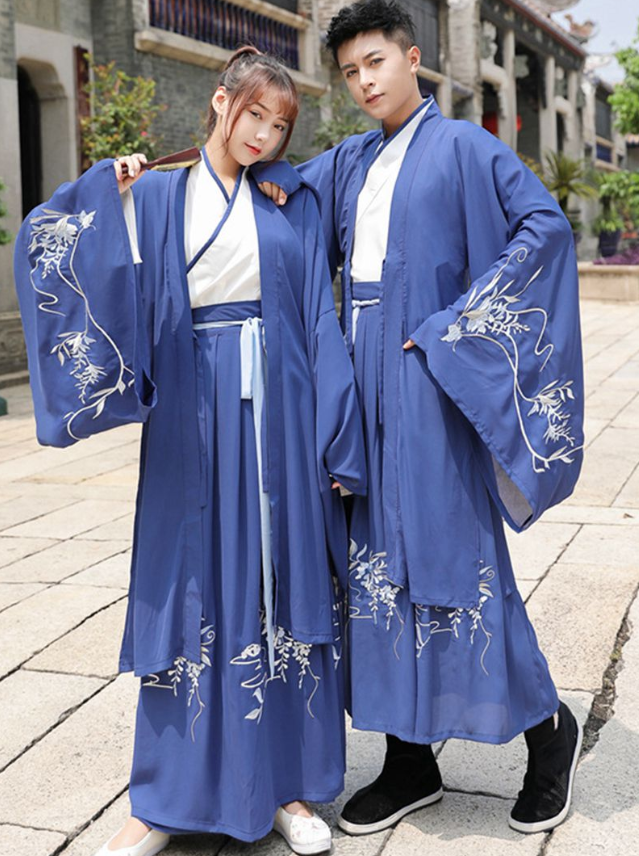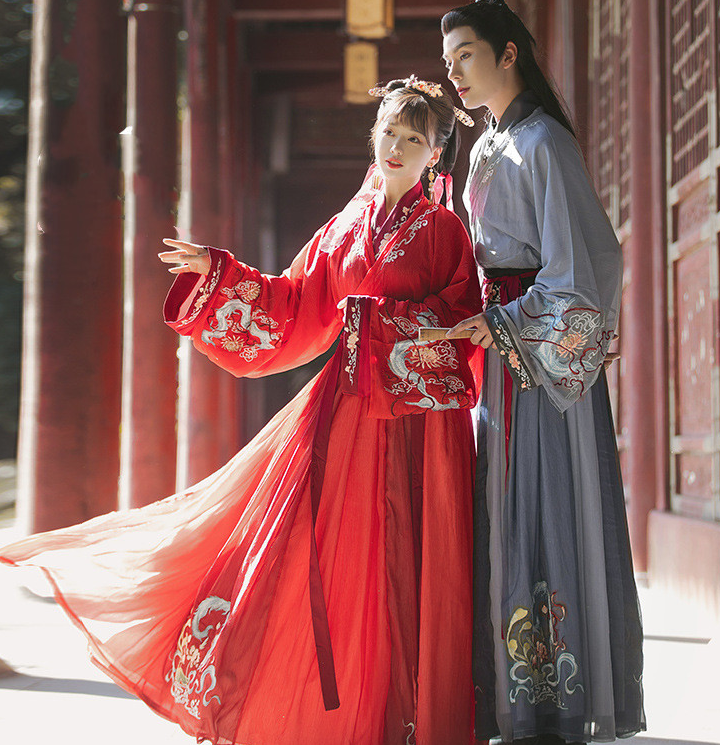Smart VPN is a virtual private network service that automatically selects the optimal server based on your needs and location, providing faster and more secure connections.
Basic Components of Hanfu
Hanfu, the traditional dress of the Han Chinese people, comprises several elements that differ between men and women. Below we explore these essential components, breaking them down into upper garments, lower garments, and accessories.

Upper Garments
Shenyi: One of the most ancient forms of Hanfu, the Shenyi is a one-piece garment that combines both the upper and lower parts. It’s a symbol of elegance and simplicity.
Ruqun and Beizi: These are typical for women. Ruqun consists of a top blouse (Ru) and a wrap-around skirt (Qun). Beizi is an optional vest or robe that goes over the Ruqun.
Yishang: This is a popular men’s attire, consisting of a top (Yi) and bottom (Shang). Men often wear it for formal occasions and ceremonies.
Banbi: A half-sleeve, short jacket that both men and women can wear.
For more information on the types of upper garments, visit the Hanfu Wikipedia page.
Lower Garments
Chang: These are wide-legged pants commonly worn by men. They are comfortable and ideal for day-to-day activities.
Ku: These are trousers or pants that can be worn by both men and women, often made from soft fabrics like silk.
Qun: The skirt component in the women’s Ruqun ensemble. It’s usually floor-length and wrapped around the waist.
To delve deeper into the styles and types of lower garments, consult the Han Chinese Clothing Wikipedia page.
Accessories
Headwear: Different types of hats and headpieces are common, such as the Guan for men and women’s floral headdresses.
Footwear: Cloth boots and cloud-pattern embroidered shoes are prevalent. Men’s styles are often more straightforward, while women’s shoes might include intricate embroidery.
Belts and Sashes: These not only serve a practical purpose but also often carry cultural significance. Jade belts, for example, signify nobility.
Jewelry: Women often wear intricate necklaces, bracelets, and sometimes even hairpins made of precious metals and stones.
Differences in Male Hanfu
Understanding the distinctions in male Hanfu can offer a deeper insight into Chinese history and culture. Below, we explore the various types of male Hanfu, the preferences for fabrics and patterns, as well as the cultural meanings attached to them.
Types of Male Hanfu
Yi: This is the upper garment that comes in different styles such as Zhiduo and Daopao, often worn for scholarly activities or official events. Zhiduo is a more casual style, while Daopao is strictly formal.
Shenyi: A unified garment that represents a higher social status, often worn during ceremonies or by scholars and officials.
Pifeng: A sleeveless jacket worn over the robe, adding an extra layer for warmth and style.
For a comprehensive list and history of male Hanfu types, feel free to visit the Hanfu Wikipedia page.
Fabric and Pattern Preferences
Silk: A favorite for its smooth texture and luxurious look, silk often appears in formal Hanfu.
Linen and Cotton: These are more common for everyday wear due to their comfort and breathability.
Patterns: Dragon and phoenix motifs signify nobility and power, while floral and nature patterns are common for casual wear.
To learn more about the fabrics traditionally used in Hanfu, consult the Han Chinese Clothing Wikipedia page.
Cultural Connotations
Social Status: The type and quality of Hanfu can indicate the wearer’s social standing. For instance, Shenyi and silk garments often denote higher status.
Occasions: Certain types of Hanfu are suitable only for specific occasions, like ceremonies or festivals. Yishang and Shenyi, for example, are usually reserved for more formal events.
Symbolism: Elements like color and pattern carry symbolic meanings. Red, for instance, represents good luck and joy, while blue might signify tranquility.
For a more in-depth understanding of the cultural significance of male Hanfu, the Hanfu cultural history on Wikipedia can be a valuable resource.
Differences in Female Hanfu
The intricacies in female Hanfu go beyond mere fashion, reflecting historical and cultural shifts over the millennia. In this section, we will delve into the types of female Hanfu, their fabric and pattern preferences, and their cultural implications.
Types of Female Hanfu
Ruqun: A two-piece outfit consisting of a blouse (Ru) and a skirt (Qun), Ruqun is one of the most iconic forms of female Hanfu. It comes in various styles and lengths, suitable for different occasions.
Aoqun: Similar to Ruqun but with a more formal top (Ao), often featuring elaborate designs or embroidery.
Zhiju: A straight, flowing robe with wide sleeves, typically worn for casual occasions or daily activities.
For more on female Hanfu types, you may consult the Hanfu Wikipedia page.
Fabric and Pattern Preferences
Silk and Brocade: Preferred for formal occasions and ceremonial wear, these luxurious fabrics are often heavily embroidered.
Cotton and Linen: More practical and suitable for daily wear, these natural fabrics offer comfort and ease of movement.
Patterns: Floral and bird motifs are common, each with its own set of cultural meanings. Peonies, for instance, symbolize prosperity, while cranes stand for longevity.
For further details on the fabrics and patterns commonly found in Hanfu, you can visit the Han Chinese Clothing Wikipedia page.

Cultural Connotations
Social Status and Age: Just like with male Hanfu, the style and quality can indicate a woman’s social status. Additionally, some styles are more appropriate for certain age groups.
Occasions and Activities: Specific styles cater to activities such as tea ceremonies, festivals, or religious events. For example, Aoqun is often worn during formal gatherings.
Symbolism: The colors and patterns on female Hanfu carry symbolic significance. Red represents good fortune, while green symbolizes youth and vitality.
Unisex Hanfu Styles
As society evolves, so does fashion, and Hanfu is no exception. While traditional Hanfu often has distinct styles for men and women, unisex Hanfu styles have emerged to fit the fashion needs of both genders. Below, we explore these common styles and contemporary trends in unisex Hanfu.
Common Styles that Fit Both Genders
Banbi: This half-sleeve, short jacket serves both functional and aesthetic purposes and can be worn by both men and women. It’s versatile, often complementing various types of Hanfu garments.
Shenyi: Although traditionally gendered, modern interpretations of Shenyi have become increasingly unisex. The robe’s flowing design accommodates a variety of body types and styles.
Changshan and Qipao: Originating from Manchurian influences, these styles have transcended their initial cultural boundaries to become popular unisex options in modern times.
For a thorough list of unisex Hanfu styles, the Hanfu Wikipedia page provides ample information.
Contemporary Trends in Unisex Hanfu
Modern Fusion: Mixing Hanfu with modern fashion elements, like denim or leather, creates a contemporary look that appeals to both genders.
Adaptive Styles: As fashion becomes more inclusive, Hanfu designers are creating adaptive styles that are easy to put on and take off, making them more accessible to everyone.
Sustainability: Gender-neutral Hanfu made from sustainable materials like organic cotton and hemp are increasingly in demand, echoing global fashion trends toward sustainability.
Social and Cultural Context
The significance of Hanfu transcends its role as mere clothing; it’s deeply interwoven with the social and cultural fabric of Chinese society. In this section, we explore the role Hanfu plays in traditional ceremonies, its relevance in modern-day China, and its representation in popular media.
Hanfu in Traditional Ceremonies
Weddings: In traditional Chinese weddings, Hanfu is often the attire of choice, especially for rituals like the tea ceremony. The bride and groom might wear matching Shenyi or Ruqun, symbolizing unity and harmony.
Festivals: During festivals like the Lunar New Year and Mid-Autumn Festival, it’s common to see people dressed in Hanfu to honor their cultural roots and partake in traditional activities.
Religious and Ancestral Rites: Hanfu also appears in ceremonies associated with Confucianism, Taoism, and ancestral worship, serving as a bridge to ancient customs and beliefs.
For further insights into Hanfu’s role in traditional ceremonies, you may find the Hanfu Wikipedia page useful.

Hanfu in Modern Day China
Fashion Revival: The 21st century has seen a resurgence of Hanfu as a fashion statement among the youth. Social media platforms like Weibo and even Hanfu-focused events help popularize this traditional attire.
Cultural Identity: As China undergoes rapid globalization, Hanfu serves as a way for people to connect with their cultural heritage.
Tourism: Various cultural sites and historical landmarks encourage visitors to rent Hanfu, immersing themselves in the experience.
For more information on Hanfu in contemporary China, the Hanfu modern trends section on Wikipedia can be an enlightening read.
Hanfu in Popular Media
TV Dramas and Films: Period dramas like “The Untamed” or “Eternal Love” have played a crucial role in bringing Hanfu to a broader audience.
Video Games: Games like “Dynasty Warriors” incorporate Hanfu designs, offering an interactive way for players to engage with this traditional attire.
Pop Music and Performances: Chinese pop stars sometimes don Hanfu in their music videos or live performances, further popularizing the attire among younger audiences.
Comparative Analysis
Understanding Hanfu requires more than just a superficial glance. By conducting a comparative analysis of its aesthetic differences, functionality, and historical evolution, we can gain deeper insights into this significant aspect of Chinese culture.
Aesthetic Differences
Color Palette: While both male and female Hanfu often employ vibrant colors, female Hanfu tends to have a broader range, incorporating softer hues like pastel pinks and brighter ones like crimson.
Embellishments: Female Hanfu may feature more intricate patterns and embroidery, often with floral or bird motifs, whereas male Hanfu tends to have simpler, more subdued designs, like dragon and phoenix patterns.
Layering: Male Hanfu usually employs less layering compared to its female counterpart, which often boasts multiple layers, especially in formal settings.
For a comprehensive comparison in aesthetics, the Hanfu Wikipedia page offers more details.
Functionality and Practicality
Material: Male Hanfu often utilizes heavier fabrics like wool for warmth and durability, while female Hanfu may favor lighter materials like silk for elegance and comfort.
Flexibility: Unisex styles, increasingly popular today, offer more flexibility, being functional for a range of activities from daily wear to formal events.
Weather Adaptability: Some types of Hanfu, such as the Pifeng, offer adaptability to weather conditions and can be worn by both genders.
To understand the functional aspects of Hanfu, consult the Han Chinese Clothing Wikipedia page.

Historical Evolution
Dynastic Influence: Different Chinese dynasties have influenced Hanfu styles. For example, the Ming Dynasty popularized the Aoqun and Ruqun, while the Song Dynasty had its own distinct styles.
Western Influence: Over time, elements of Western clothing have been integrated into Hanfu, particularly during the late Qing Dynasty and modern times.
Modern Revival: The 21st-century Hanfu movement has led to a resurgence of traditional styles, combined with modern fashion sensibilities.







